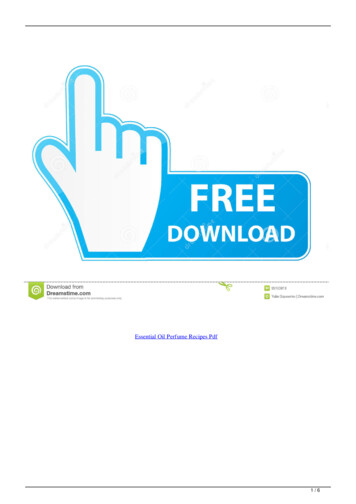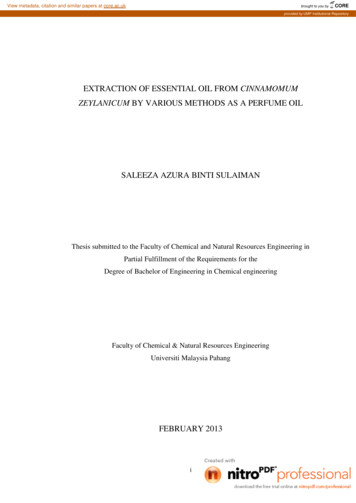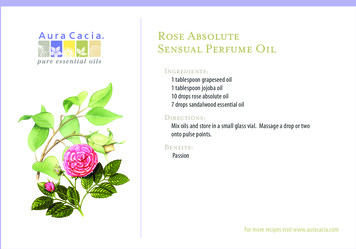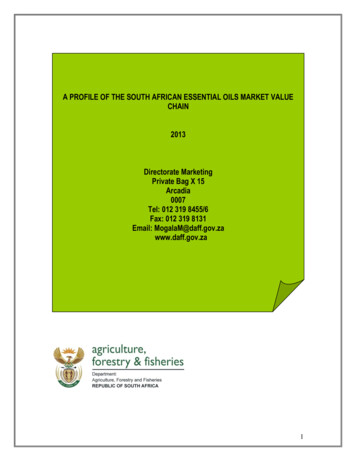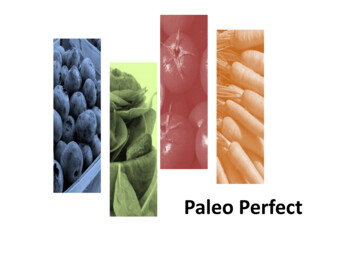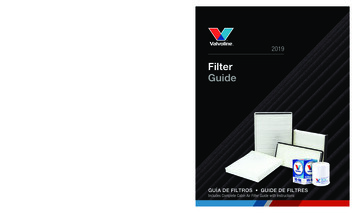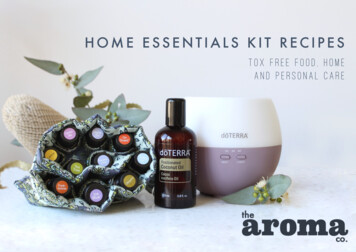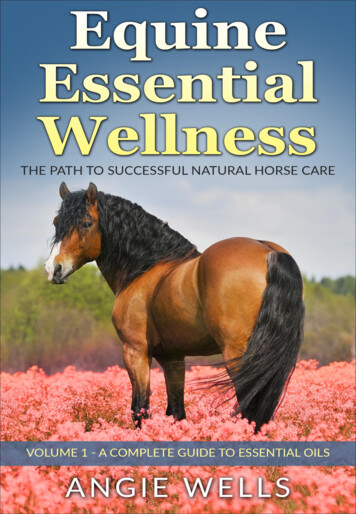
Transcription
Complete Essential Oil GuideTable of ContentsIntroductionA look at the storyand inspiration of thisbook.Chapter 1Finding hope throughessential oils and basicprinciples to understand.Chapter 2An overview to healthand disease.Chapter 3Benefits of essentialoils and the goal ofpromoting health.Chapter 42 of the most commonmistakes horse ownersmake to increase concernChapter 5Supporting digestivehealth and theGI tract.Chapter 6Supporting therespiratory, cardiovascular,and hematopoietic system.Chapter 7Supporting theMusculoskeletal andNervous systemChapter 8Supporting emotions,behaviour, and trainingsessions.Additional ResourcesGreat resources that Ifound and studied on myjourney.www.equineessentialwellness.com2
Disclaimer NoticeThe information contained within this publication is for educationalpurposes only and is not meant to substitute for medical care or toprescribe, treat, or diagnose any specific health condition. We highlyencourage readers to do further research and education on the properuse of essential oils prior to application. If your horse has a health issue,disease, illness, or injury, please contact a qualified veterinarian for careand treatment.3
IntroductionIf you were to tell me 10 years ago that I would be creating content andempowering horse owner’s to promote their horses’ health through essentialoils, I would have thought you were crazy! My passion and drive for naturalhorse care started shortly after high school. As a teenager trying to choose acareer path, I knew it was supposed to be with horses, I just did not know whatwould be a good fit for me. Our high school offered internship elective coursesand I saw this as a great opportunity to try to find my niche.The first internship I did was with a couple, that had given me lessons when Igot my first horse (Pokey). Although I did admire their way with horses, theywere kind and seemed to work with the horse and not force them or useaggressive methods. There was a lot of things I did not like and I saw that therewas little connection with the horses, they seemed so “trained” they werealmost robotic. One of my jobs was to warm up and sometimes just exercise thehorses. Often this consisted of mindless trotting and cantering in circles for 30minutes to an hour. It was no wonder most of these horses were not connectedand were almost numb. I learned so much during my time at this facility but atthe end of the internship, I felt no closer to finding where I wanted to be.My next internship was at a cutting horse trainer. He was nationally knownand had horses that were valued over 50,000- 75,000. Since my first horsewas 100 and to adopt my mustang was 125, I was in awe of these horses andthrilled to have an opportunity to work with them. Sadly mid-way through myinternship I found I was dreading going to the barn. It was my job to run thehorses out and cold hose them after they were worked by the trainer. Some ofthe methods and tactics I saw done to these horses broke my heart. I wascertain this was not the area of the horse industry I wanted to work in.4
IntroductionSeeing the wounds and injuries of those horses led me to believe I wanted tobecome a vet tech. So that inspired my next internship. I interned for a local equineveterinary practice. I was excited to help horses get well and resolve horse healthconcerns and mysteries. Sadly, I was let down here too. There were often timeshorses had to be euthanized, or after procedures and medications would still be ill orthen returned often with continued or worse injury or illness. The things I saw, heard,and was taught, actually horrified me! I was really beginning to wonder where in thehorse industry I could fit in.After high school I began to explore alternative and natural paths of care andtherapy which has led me to where I am now. I hold an Equine Massage & EquineSport Trainer Certification and have continued my education and experience in thealternative therapy field ever since. The first half of my journey did not involveessential oils and I was also not in the mindset that it ever would.My current mentor at the time that I greatly respected was very open tovarious natural modalities and remedies but she was very clear that essential oilswere dangerous, unpredictable in their results with horses, and nothing I wanted topursue. Being young and naïve I stuck with that plan until life forced me to change it Image above: my first horse Pokey and her grazing bunny Deuce.5
Chapter 1As horse owners we all have at least one horse that has made anunbelievable impression on our lives. For me that is my mare Pokey. She was myfirst horse and is the inspiration that shifted my view and understanding ofessential oils. Around 2011 Pokey began to exhibit advanced and quicklyprogressing signs of a neurological disorder. I sought out assistance from 3different veterinarians, had an extensive amount of blood tests performed, withno answers or recommendations other than euthanasia.I was devastated and was not at peace with putting her down. Not onlybecause of the obvious emotional reasons, I truly did not feel that was what shedesired. Pokey did not seem ready to let go. So my search for options began.She was receiving regular bodywork sessions from massage, chiropractic, toacupuncture. She was given herbal options, flower remedies, homeopathy, andher diet had been set to a very organic, chemical free ration. She would makeimprovements but they would not hold and often times the symptoms wouldget worse with no sign of positive progression. After a year of exhausting everyremedy, resource, and contact I had, I began to question if putting her downreally was the best option.Some days she struggled with what seemed to be temporary blindness ordementia. Standing frozen in the corner of her pen, hollering as if she werealone with my two geldings in a pen along side her. During those times if Ientered the pen she would panic like a wild horse fearful of being killed. Whenshe wasn’t in these dazes she would be propped up along a panel, leaning herhindquarter’s against the fence for balance. The next day she could be perfectlynormal. It was a stressful time and I was desperate to help her.6
Little did I realize my misconceptions of essential oils was holding both Pokeyand I back from the results and improvement we were seeking. Finally one daywhile straining and hurting over the situation with my mother on the phone, Istarted to convince myself to make peace with Pokey’s fate. My mother whohad used and loved essential oils since I was a child asked what harm couldreally be done in trying the essential oils with Pokey. After all if my only otheroption was death, wasn’t it worth a shot?Snidely, I agree to try some, although I was quite certain not only would theynot work, but that she would have welts or an onslaught of issues as a result.The fear and rumors I had heard and yet believed at the time to be true loomedin my head. I drove to my mother’s and picked up a few oils, the ones that I feltstunk the least and home I went to apply them.I went out not knowing really even how or where to apply the oils, the YoungLiving Valor blend was the one I liked the most and decided to give a try. Icouldn’t even tell you how much I applied, I simply put some in my hands andintuitively decided to place some at her atlas bone, then along the sides of herneck, spine, and down the hind legs There I thought to myself. I tried it, itwon’t work and I will decide what my next step is tomorrow.Only when I went to feed her that night I noticed she was more balanced andseemed better in spirit. Still skeptical I went inside and didn’t think much aboutit. Much to my surprise she looked good the next day as well. To test out howlong the results would last I waited for about 3 or 4 days, before I felt I shouldapply them again when I did her regular bodywork session. From then on shelooked better and better everyday! That summer I even had the opportunity torun poles and barrel race on her. My amazement drove me to learn what I couldabout essential oils, which turned into the inspiration of this book and theeducation options on our website.7
I guess to make it sound as if my trust was solid and established in essential oilsimmediately would not be accurate. My drive to research was two sided. I wanted tounderstand how they delivered the results I was seeing in Pokey, but I also wascertain there was a catch. That danger zone that I was told and taught to believe justhad to be true, right?What I discovered was most misconceptions and so called risks could be tied tothe fact that not all essential oils are created equal! This is a very important andprobably most important thing to know and understand if you plan to use essentialoils with horses.Much like the abuse of the terms organic and natural in our market place theterm essential oil can be used to describe oils that were distilled or pressed from theplant itself as well as those that are completely derived in a lab to match thechemical makeup of that of the plant.I am often teased of how concerned or upset I get when someone suggests itdoesn't matter where you purchase your essential oil and that they are all the same.Even typing it makes me cringe inside! On the next page I will share an analogy, thatalthough might seem simple or cliché, is quite powerful and clearly paints a pictureof the difference in how oils are made, produced, and manufactured.8
Stop and Smell the RosesSafety & ResultsCome from QualityImagine someone giving you abeautiful bouquet of roses. Now pictureand feel what it is like as you bring theseroses up to your nose, they are touchingyour skin and you get ready to inhaletheir fragrance. oh I forgot to mentionthey are synthetic roses. That doesn'tchange what you where imaginingthough right? Wait it does?!? Well sayingthat synthetic flowers are the same asreal flowers is what you are saying whenyou say all essential oils are the same.There is a use for synthetic essentialoils but not if you are wanting atherapeutic result! It can be a challengeto find and trust a company to purchaseyour essential oils from, but I have sometips to help you.I hope the simple analogy of fakeflowers vs real ones gives you a clearimage of what a synthetic adulteratedessential oil is vs a therapeutic gradeessential oil.Hopefully it can help you understandwhy we care so much about the grade ofyour essential oil as you are using themtopically, as well as internally with yourhorses. This is one of the most importantunderstandings to have of essential oilsand utilizing them safely.There are some practical ways that Iwould like to share with you that canhelp you determine the grade of youressential oil.9
Understanding and looking at the following aspects of your essential oil itselfand the company or manufacturer that you purchase it from: shelf life, texture,price, listed plant genus, container, cultivation and distillation process, aromapotency, and school of thought.The shelf life of an essential oil can be an indicator of the presence of carrieroils or synthetics. Now that is not to say that some blends may not need to betossed or replaced over time but if you have an essential oil, especially a single,that is showing an expiration date or is recommending that it be replaced withina year or two, you might question the quality of that particular oil. You can alsolook up the competitors oil to see if they are following the same suggestions.This would be a good way to ensure that it is not the traits of a particular oil tonot last as long. As I noted above, be mindful that some blends utilize a carrieroil and that is something to beware of. This can sometimes shorten a shelf life.That being said we have had blends and singles that have been stored properlythat still smell the same up to ten or fifteen years even after being opened. Thatis a sign of therapeutic quality. I also have a Lavender oil I purchased from alocal natural grocer that is only two years old and will turn your stomach whenyou smell it. Not an encouraging sign of quality.The texture of an essential oil is another way to “test” the quality or grade.Be sure to check and understand your ingredient list. If it is a blend that utilizescarrier oils this test may not be helpful. There are also some oils likeSandalwood, Vetiver, etc. that have a different consistency to them and this testwill not apply. If you take a couple drops of your essential oil and rub it betweenyour fingers or drop a few drops to the back of your hand it should absorb fairlyquickly and there should not be an oily feel or residue. If you are feeling veryoily, sticky, or there is a film or residue present, you may do a quick research onthe specific essential oil you are testing to be sure it is not an oil that has aunique texture to it. If you are not finding that to be the case you may want topurchase from a different producer before you use that essential oil fortherapeutic purposes with your horse.10
This is not a time to go bargain hunting! If you are planning to apply and useessential oils internally or even topically for therapeutic use don’t be fooled bycheap, bulk, or outlet type suppliers. Often times the companies that offertherapeutic grade essential oils will be in a similar price range for eachparticular essential oil. I don’t recommend going off this step alone. There mightbe local farms that can offer certain oils at a reasonable price or largecompanies that can produce very large quantities and offer great deals. But thisis definitely an industry where you often get what you pay for quality wise.Look for the plants Latin name to be on the bottle. Sometimes it can beinteresting to do a little research to see what the benefits and characteristics ofthe genus that is listed on the bottle. If an essential oil is synthetically derivedthis is often not listed on the label (although it can be). Even on your essentialoil blends, look at the ingredient list to see if each essential oil listed has a Latinname listed with it.Some plants have hybrids or a variety of genus within that particular plantspecies. Knowing the specific genus will help you determine if you are beingsold a more available “sister” genus that may not have the same therapeuticproperties. Lavender and Frankincense are examples of common oils that areoften misrepresented or sold in such a way.The container your essential oil is in can be an indicator of the grade andquality of the oil. Therapeutic grade essential oils will be sold in a dark coloredglass bottle and often times will have an orifice reducer inside the cap. If youare dealing with massage oil blends, sprays, or cleaners this may vary. But stilllook for a darker colored bottle to prevent sunlight penetration. As mentionedin previous steps, don’t go off this step alone. Use the guide in its entirety tohelp you determine the quality of your essential oil. Many companies are on tothis tip and market synthetic essential oils accordingly.Don’t just trust labels that claim 100% natural or pure. Look into thecompanies cultivation and distillation process. The companies offeringtherapeutic grade essential oils should understand that this is important to theircustomer and should have a website or information on their standards for how,when, where, and what they do to cultivate and process the plants, all the waythrough the distillation process.11
There are specific ways to best utilize each oil whether it be internal dietaryuse, inhalation through diffusing, or topical use. The label on your essential oilshould clearly list the ways best to use the essential oil. But if there are veryclear “DO NOT USE FOR” type warning labels on your essential oils I would beconcerned. Even essential oils not best used internally should not be considereddangerous if consumed. Many times during my therapy session horses chooseto lick the essential oil I am using. If I see essential oils with “do not use topicallyor do not consume internally” I will choose to steer clear of them! Essential oilsshould be natural products that you do not need to “fear”. There are essentialoils that are toxic for cats, and others that should not be utilized for animalswith seizures or other chronic conditions. The warning labels I am discussinghere are very generalized and as mentioned might leave you very hesitant touse it.When you are new to essential oils it can be hard to distinguish the grade byscent but as you start to expose yourself to them more you will naturallydevelop this “skill”. But until you feel confident in this area you can revert backto the texture test and run a “scent” test on the hand you placed your dropson if the scent only lasts 15-30 minutes I would question the quality. Alsowhen you apply or open a bottle of therapeutic grade essential oils you will findthat people around you can smell them, even from across the room. This is dueto the size of the molecules of the essential oil and can be a good way to testthe quality of your oil.This might seem like a strange step or method but in the world of essentialoils there are “schools of thought” that are almost like a culture or belief systemto how one sees and thinks an essential oil should or should not be used.Determining what school of thought you believe as well as what a supplierseems to emulate will help you in finding what you are looking for. This is ageneralization of the current schools of thought: British school of thought uses more diluted and less “pure” essentialoils. Often has many warnings or cautions with certain oils. German school of thought tends to lean toward aromatherapy andinhalation of essential oils. Not much belief or use topically orinternally.12
French school of thought is considered very open and pure to various usesof essential oils with the use of science to help back it.This gives you an overview of what to look and watch for as you select qualityessential oils. There is one more trick that some manufactures' can pull that I wantto help you look out for, substitutions of extract.An essential oil is a volatile substance extracted from plants, that carries thenatural aroma and characteristics of the plant it came from. Volatile meaning themolecules rise quickly and create an aroma in the surrounding area. Although bothmay be used in aromatherapy, it is the essential oils which carry the therapeuticqualities and are best to be used when a therapeutic result is desired. Extracts aremainly used in perfumes or even in cooking.The process of obtaining a plant extract varies from cold compressing or beingsoaked in a liquid such as an alcohol, in order to isolate a certain quality (aroma orflavor) from the plant. For essential oils steam distillation is the most popularmethod of extraction. This method, when done properly, will preserve the terpenes,esters, ketones, alcohols, and phenols of the plant itself. This is why many peopledescribe essential oils as the life blood of the plant.So why would companies substitute? One reason is it takes a large amount ofplant material to make a small amount of essential oil, so it can be a way to cutcorners, plump, and fill their essential oil products with extracts and synthetics. Thatsaid there are times when cold pressed or absolute methods of extraction is anecessary process, like with citrus oils and some plants that the material is toodelicate to steam distill.13
ExtractionThere are 4 common methods of extraction:1. Steam Distillation- most common2. Cold Pressing- used for citrus oils and fatty oils3. Resin Tapping- used for oils like Frankincense, Myrrh, and Copaiba4. Absolute Oil Extraction- most complicated- used for plant material thatis especially delicate, this process requires use of a solvent.Common ApplicationONETopical- applying the essential oil topically to skin. Whetherapplied NEAT or with a carrier oil. Use a natural carrier oil such asan olive, coconut, or almond oil. It is not recommended to dilutewith petroleum derived or based products or synthetic gels.TWOInhalation- Through the airand breathing in the oil. Youcan do this using an essentialoil diffuser. For horses theirhair is a great natural diffuser.Just letting them smell theopen bottle is a way to“apply” the oil.THREEInternal- Using as a dietary supplement either directly onthe tongue, diluted in water, or put into a capsule. Forhorses adding to their grain ration or a cookie is a greatdietary option.14
Chapter 1 SummaryFrom this chapter you should havean awareness and understandingof the following: You have hope and a vision thatessential oils can improve uponyour horse’s health. Awareness of the importanceof an open mind. A firm understanding that notall essential oils are createdequal. Tools for determining the gradeof the essential oil you areworking with. The difference betweenextracts and essential oils. 4 common extraction methods 3 common applicationmethods.If you want specific details anddescription of extractionprocesses, check out the onlinecourse that compliments thisguide.15
Chapter 2When I started in the alternative therapy industry, natural horse care andremedies were used more just as the name implies as an “alternative” to justtraditional treatment. We looked at the symptoms and utilized natural remediesto support and comfort the result of those symptoms. This is still a commonpractice and from my experience will lead down the same path as traditionalallopathic care and treatment. The symptom will be driven deeper orsomewhere else in the body and illness and disease will continue to fester,surface, and manifest.By definition alternative therapy is- any of various systems of healing ortreating disease (such as chiropractic, homeopathy, essential oil, faith healing,etc) not included in the traditional medical system. Although I don’t see thisdefinition as inaccurate it is not how I like to view or explain it.My view alternative therapy is taking responsibility for the current state ofhealth or disease and taking the necessary choices and actions to improve andmaintain health from that point. For horse health it is of course, the ownertaking responsibility for the current state of health of the horse.There are many cases where a horse’s state of disease, illness, or injury is adirect result of the environment and situations that we place the horses in. Ashorse owners we need to provide the proper care, nutrition, exercise, andenvironment to support the health and wellness of the horse.Some might think I am not open to “traditional medicine” but I believe thereis a definite place and purpose for both alternative therapy and traditionalmedicine. In times that traditional medicine is necessary, I prefer combining thenatural therapies supporting along side.16
It can be difficult at times as the traditional veterinarians are not alwaysopen or in support of alternative therapies, and this is when owner education iskey.In his book The Battle for Health Is Over pH: Life and Death Hangs in theBalance, Gary Tunsky uses an analogy that is helpful. He describes someonetaking their car into a mechanic because the engine light has come on. Themechanic tells the customer not to worry and can take care of the issue. Hethen proceeds to cut the wire to the check engine light and sends the customeron his way.Now none of us would be happy with this situation and yet many timeswhen we call our veterinarian for our horse’s health something similar canhappen. We are given a pill, paste, or pharmaceutical that will “shut off theengine light”, but will not deal with the original cause of the signal. Promotingthe horse’s health through nutrition, natural remedies, and proper emotionalprocessing, can help bring balance and restore wellness.It is important to understand there are varied views and understandings ofhealth and disease. Much like the school of thought we discussed in Chapter 1.For the purpose of this guide we will cover the rationalist school of thoughtwhich primarily focuses on external pathogens, the disease itself, and thesymptoms. Most traditional practitioners and veterinarians have been educatedwith this theory, even some of the natural or holistic practitioners as well.The opposite side I have heard described as empirical school of thought.Their primary focus is on the terrain of the body as a whole, also will look tomental and emotional patterns as pertinent to health. The symptom is “heard”and rather than looking to suppress, the practitioner is looking to support thebody through, while working to pinpoint the cause of the disruption in healthand homeostasis.17
So if health and disease are simply the difference in harmony and balance,what can cause a tip in the scales? The Eight Laws of Health can weigh the scalein either direction, for health or for disease. When laws and boundaries areupheld and followed there is peace and reward, but when laws are broken thereare repercussions and consequences. In Naturopathy, the Eight Laws of Healthare the foundational laws that are trusted and assessed when looking topromote or maintain the health and wellness of an animal or a person.The Eight Laws of Health1. Nutrition2. Exercise3. Water4. Sun5. Temperance6. Air7. Rest8. TrustThese eight laws show that health is not left to chance or luck, but issomething that can be built, supported, and even repaired when lost. Abidingby these laws will give animals the foundation of health they would havenaturally pursued in the wild. It is the duty and responsibility of the animalowner to allow and support the abiding of these laws for their domesticanimals. Because of humans, many of the current diets, supplements, and livingsituations animals are in, violate these laws and the results are many diseasedand ill animals that are uncomfortable or suffer daily. Often resorting toeuthanasia at younger ages over time.With such noble and common sense principles and laws of health it is hardto comprehend how our current health care system came to rely on toxicchemical pharmaceuticals and disease/germ fear and battle tactics. There are afew pivotal people in history that have shaped the current health care andmedical system into what it is today.18
Germ Theory Louis PasteurLouis Pasteur was a French chemist andmicrobiologist renowned for hisdiscoveries of the principles ofvaccination, microbial fermentation andpasteurization.Thehistoryandbackground of Louis Pasteur is one full ofdeceit,power,connection,andplagiarizing. Pasteur’s flawed anddisproved germ theory is still whatdoctors and physicians are taught inmedical school to this day. The germtheory is the basis and foundation ofmodern medicine.The monopolization and controlcontinued with the money, power, andinfluence of John D. Rockefeller, FredrickTaylor Gates, and Andrew Carnegie.Through utilizing the “The FlexnorReport” and only funding programs,schools, and research that favored theirown petrochemical companies as the“cure”, they shaped and molded aneducational system and medical systemin which they controlled the competitionand the knowledge of medicalphysicians.Terrain Theory Antione BechampThere is an alternative theory, that if itwas better known and understood,would revolutionize the way people lookat disease, germs, and pathogens. Theconcept and theory of pleomorphism.Pleomorphism was developed by Frenchbiologist Antoine Béchamp, LouisPasteur's largest counterpart. UnlikePasteur’s belief that germs andpathogens are something we need tofear and wage war on, Béchampdiscovered that it is the environment ofthe cells that will determine health ordisease. By improving what Béchampcalled the 'milieu', the environment ofthe cells, the so-called pathogens did notdisappear but aided in repairing thecells.19
What we focus on grows, in the case of health, the same concept is true.Through focusing on health instead of disease, Béchamp discovered that thepathogens or micro-organisms worked towards health instead of disease. WhenBéchamp focused on eliminating the disease or pathogen they would becomestronger, harder to combat, and even morph. Through supporting a healthycellular environment, cell regeneration and wellness can be restored withoutattacking or combating disease, bacteria, or pathogens. When symptoms ofdisease surface it is a sign that the environment of the patient’s cells is toxic andneeds to be restored and set to balance.The germ or pathogen is Nature’s way of cleaning morbid matter from thebody. Liken them to the body’s garbage men. Attacking and destroying thegarbage men will only leave more garbage. The right thing to do then, is to dealwith the “garbage”, the morbid matter and environment. Support the body withproper nutrition, get the blood and lymph flowing, and naturally aid the bodyinto a homeostasis where morbid matter ceases to exist. Germs and pathogenswill then not have what they need to thrive and are no longer needed by Natureto bring balance and will no longer be a concern, even if they are still present inthe body. “Bacteriologists are unanimous in declaring that various diseasegerms are found not only in diseased bodies, but also in the bodies of seeminglyhealthy persons.” Henry LindlahrSince our current medical system is not based on Béchamp's theory, societyis taught and encouraged (sometimes required), to use vaccinations, toxicpreventive care measures, antibiotics, and other toxic drugs and chemicals tokill or fight pathogens, bacteria, and viruses. As mentioned in the previousparagraph, attacking these “intruders” only strengthens the pathogens andcauses them to get stronger and even morph. Meanwhile the patient getsweaker and their body becomes unable to process cell restoration andregeneration, because the cellular environment continues to become more toxicand only fuels the disease and illness further. “Super bugs” like MRSA are reallife examples of the morphing and strengthening that can occur with patho
Complete Essential Oil Guide Introduction A look at the story and inspiration of this book. Table of Contents Chapter 1 Finding hope through essential oils and basic principles to understand. Chapter 2 An overview to health and disease. Chapter 4 2 of the most common mistakes horse owners make to increase concern Chapter 3 Benefits of essential


